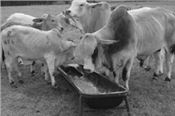|
Cattle Producers Face Price Declines Amid Coronavirus Pandemic

Brahman cattle feed in Vermilion Parish, one of the largest cattle-producing parishes in Louisiana. Cattle prices are
depressed because of the coronavirus.
Photo by Bruce Schultz/LSU AgCenter
CROWLEY, LA.
Cattle producers are facing significant price declines because of the coronavirus pandemic. LSU AgCenter economist Kurt Guidry said prices have fallen about 7 percent in two months for fed cattle, or animals that are ready for slaughter. The average live-fed steer price across the five major feedlot areas in the country was $124 per hundredweight in January 2020. The price fell by $4 in February 2020, and has averaged about $112 this month.
“This is at a time when we normally see seasonally higher fed cattle prices in March, April and into May,” he said. “Much of this is likely associated with uncertainty regarding both domestic and international demand for beef.”
The time is approaching when producers will be selling their fall calves, and generally, beef demand increases with the approach of summer.
For calf and feeder cattle prices, the market has seen a similar decrease in prices as compared to fed cattle, Guidry said.
“As the fed cattle market starts to fall, feedlots and backgrounders can’t afford to pay as much for calves, and so we see downward pressure on calf and feeder prices,” he said.
Prices for lower-quality cattle haven’t changed much over the past couple of months. However, prices for higher-quality cattle have fallen significantly. Local auction prices have fallen, too.
“This is at a time we normally see prices increasing, as there is more demand for calves to be put on spring pastures,” Guidry said.
Louisiana auction barns have seen the average price for a 500- to 600-pound steer fall about 6 percent since March 1.
“This is the reduction in the average price, but if you just look at the high end of price range, they are about 12 percent down from the end of February and first part of March,” Guidry said.
The cattle market overall was poised to improve until recently, with new trade agreements going into effect.
“Without any major market shock, the market looked poised to see some improvements, but I would call this pandemic a major market shock,” he said.
Recovery will probably take several months, Guidry said, but it depends on the total economic impact of the coronavirus. He said the current situation isn’t expected to change the outlook for cattle supplies, which were expected to tighten in the second half of 2020.
“Now the question is if demand is going to be at the same level originally projected at the start of the year,” he said.
It may seem like a contradiction, but beef prices have increased considerably on the wholesale and retail level. Guidry said it takes a few weeks for lower cattle prices to lower beef prices in grocery stores.
Prices jumped because consumers have been stocking up on food, including beef, in the wake of the pandemic.
“You had a huge surge in demand,” he said. “At least for the short term, you’re going to see some increase in prices.”
But if the economy continues to sputter, beef demand probably will decrease, he said, because generally, budget-stressed consumers turn to cheaper sources of protein such as chicken and pork. ∆
|
|